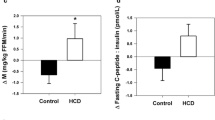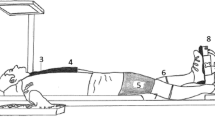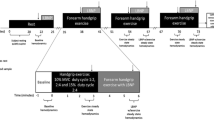Summary
Increases in plasma insulin concentration result in vasodilation in skeletal muscle but also in an increase in muscle sympathetic nerve activity (MSNA) which is thought to cause vasoconstriction. The increase in MSNA could therefore be a response to vasodilation (baroreflex), or MSNA could cause vasodilation via putative sympathetic vasodilatory fibres. To examine the relationship between vasodilation, MSNA and insulin action we studied nine non-diabetic Pima Indian men (age 29±7 years, weight 91±19 kg, 29±6% body fat, mean ± SD) during sequential euglycaemic clamps at low and high insulin doses (80 and 600 mU · m−2 min−1). Leg blood flow was measured by thermodilution, leg glucose uptake by the balance technique, arterial pressure by invasive monitoring and MSNA by microneurography of the peroneal nerve. Whole body glucose uptake (M) ranged from 6.7 to 48.3 during low dose and from 9.4 to 67.7 Μmol · kg fat free mass−1 · min−1 during high dose insulin infusion. At both insulin doses, incremental leg blood flow correlated with M (r=0.63 and 0.71, respectively). No correlation was found between incremental MSNA and leg blood flow, M or leg glucose uptake. Blood pressure was unchanged throughout the study. MSNA increased after 15–40 min of insulin infusion in all the subjects, whereas leg blood flow started to increase only after 45 min in the most insulin sensitive but not in the most insulin resistant subjects. Thus, insulin stimulates MSNA more rapidly than vasodilation. In conclusion, insulin-mediated MSNA: 1) is neither a response to nor a cause of the vasodilation observed in insulin sensitive men, 2) has no net pressor effect even in the most insulin resistant men in whom insulin-mediated vasodilation was impaired. We conclude that the effect of insulin to stimulate MSNA is dissociated from its acute haemodynamic action.
Similar content being viewed by others
Abbreviations
- MSNA:
-
Muscle sympathetic nerve activity
- LBF:
-
leg blood flow
- M:
-
whole body glucose uptake
- LGU:
-
leg glucose uptake
- NIDDM:
-
non-insulin-dependent diabetes mellitus
- EDNO:
-
endothelium derived nitric oxide, FFM, fat free mass
- MAP:
-
mean arterial blood pressure
References
Ferrannini E, Buzzigoli G, Giorico MA et al. (1987) Insulin resistance in essential hypertension. N Engl J Med 317: 350–357
Natali A, Santoro D, Palombo C, Cerri M, Ghione S, Ferrannini E (1991) Impaired insulin action on skeletal muscle metabolism in essential hypertension. Hypertension 17: 170–178
Davies M J, Metacalfe J, Gray J P, Day Jd, Hales C N (1993) Insulin deficiency rather than hyperinsulinemia in newly diagnosed type 2 diabetes mellitus. Diabet Med 10: 305–312
Jarrett RL (1994) Why is insulin not a risk factor for coronary heart disease. Diabetologia 37: 945–947
Laakso M, Edelman SV, Brechtel G, Baron AD (1990) Decreased effect of insulin to stimulate skeletal muscle blood flow in obese man: a novel mechanism for insulin resistance. J Clin Invest 85: 1844–1852
Laakso M, Edelman SV, Olefsky JM, Brechtel G, Wallace P, Baron AD (1990) Kinetics of in vivo muscle insulin-mediated glucose uptake in human obesity. Diabetes 39(8):965–974
Anderson EA, Hoffman RP, Balon TW, Sinkey CA, Mark AL (1991) Hyperinsulinemia produces both sympathetic neural activation and vasodilation in normal humans. J Clin Invest 87: 2246–2252
Vollenweider P, Tappy L, Randin D et al. (1993) Differential effects of hyperinsulinemia and carbohydrate metabolism on sympathetic nerve activity and muscle blood flow in humans. J Clin Invest 92: 147–154
Scherrer R, Vollenweider P, Randin D, Jequier E, Nicod P, Tappy L (1993) Suppression of insulin induced sympathetic activation and vasodilation by dexamethasone in humans. Circulation 88: 388–394
Baron AD, Steinberg H, Brechtel G, Johnson A (1994) Skeletal muscle blood flow independently modulates insulin-mediated glucose uptake. Am J Physiol 266:E248–E253
Baron AD, Brechtel-Hook G, Johnson A, Hardin D (1993) Skeletal muscle blood flow. A possible link between insulin resistance and hypertension. Hypertension 21: 129–135
Steinberg HO, Brechtel G, Johnson A, Fineberg N, Baron AD (1994) Insulin mediated skeletal muscle vasodilation is nitric oxide dependent. A novel action of insulin to increase nitric oxide release. J Clin Invest 94: 1172–1179
Scherrer U, Randin D, Vollenweider P, Vollenweider L, Nicod P (1994) Nitric oxide release accounts for insulin's vascular effects in humans. J Clin Invest 94: 2511–2515
Kahn AM, Allen JC, Seidel CL, Shelat H, Song T (1992) Physiological insulin concentrations cause ouabain- and verapamil-sensitive inhibition of vascular smooth muscle contraction. Hypertension 20(3):409–452
Rowe JW, Young JB, Minaker KL, Stevens AL, Pallotta J, Landsberg L (1981) Effect of insulin and glucose infusions on sympathetic nervous system activity in normal man. Diabetes 30: 219–225
Berne C, Fagius J, Pollare T, Hjemdahl P (1992) The sympathetic response to euglycaemic hyperinsulinaemia. Evidence for microelectrode nerve recordings in healthy subjects. Diabetologia 35: 873–879
Berne C, Fagius J, Niklasson F (1989) Sympathetic response to oral carbohydrate administration. Evidence from microelectrode nerve recordings. J Clin Invest 84: 1403–1408
Spraul M, Anderson EA, Bogardus C, Ravussin E (1994) Muscle sympathetic nerve activity in response to glucose ingestion: impact of plasma insulin and body fat. Diabetes 43: 191–196
Lundvall J, Mellander S (1980) Nervous control of the microcirculation in skeletal muscle. In: Kovach AGB, Sandor P, Kollai M (eds) 28th International Congress on Physiological Sciences. Adv Physiol Sci. Neural control mechanisms, vol IX. Pergamon Press, New York, pp 211–221
Lillioja S, Mott DM, Spraul M et al. (1993) Insulin resistance and insulin secretory dysfunction as precursors of non-insulin-dependent diabetes mellitus. Prospective studies of Pima Indians. N Engl J Med 329: 1988–1992
Siri WE (1961) Body composition from fluid and density: analysis of methods. In: Brozek J, Henschel A (eds) Techniques for measuring body composition. National Academy of Science, National Research Council, Washington, D.C., pp 223–244
Baron AD, Brechtel G, Wallace P, Edelman SV (1988) Rates and tissue sites of non-insulin and insulin-mediated glucose uptake in humans. Am J Physiol 255:E769–E774
Spraul M, Ravussin E, Fontvieille AM, Rising R, Larson DE, Anderson EA (1993) Reduced sympathetic nervous activity: a potential mechanism predisposing to body weight gain. J Clin Invest 92: 1730–1735
Jorfeldt L, Rutberg H (1990) Comparison of dye-dilution and plethysmographic blood flow measurements: An evaluation of the influence of invasive technique on blood flow and on arterial + femoral renous substrate variables in man. Clin Sci 79: 81–87
Morgan DA, Balon TW, Ginsberg BH, Mark AL (1993) Non-uniform regional sympathetic nerve responses to hyperinsulinemia in rats. Am J Physiol 264: R423–R427
Lembo G, Iaccarino G, Rendina V, Volpe M, Trimarco B (1994) Insulin blunts sympathetic vasoconstriction through the alpha 2-adrenergic pathway in humans. Hypertension 24: 429–438
Author information
Authors and Affiliations
Rights and permissions
About this article
Cite this article
Spraul, M., Ravussin, E. & Baron, A.D. Lack of relationship between muscle sympathetic nerve activity and skeletal muscle vasodilation in response to insulin infusion. Diabetologia 39, 91–96 (1996). https://doi.org/10.1007/BF00400418
Received:
Revised:
Issue Date:
DOI: https://doi.org/10.1007/BF00400418




